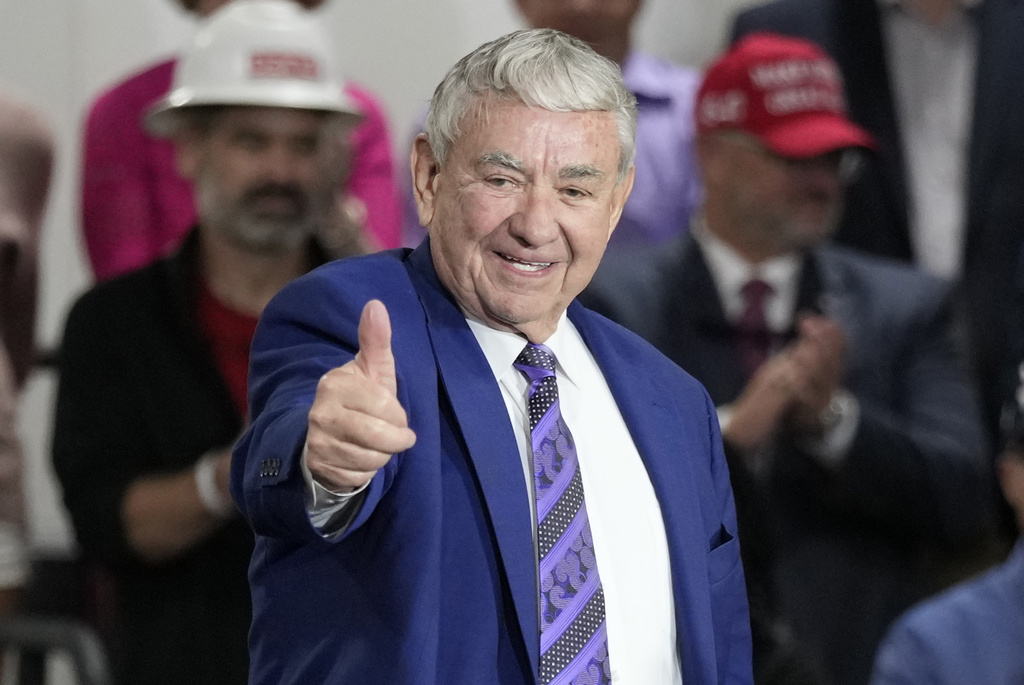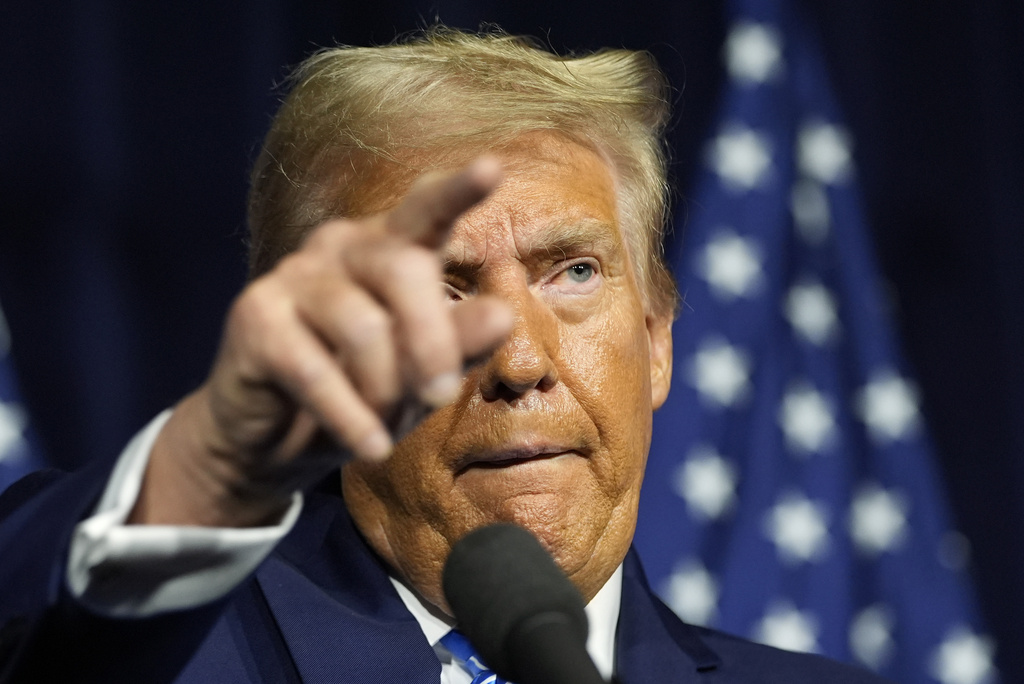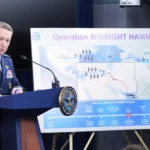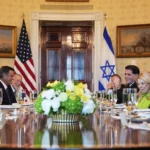Trump Campaigns in Key Wisconsin County Before VP Debate \ Newslooks \ Washington DC \ Mary Sidiqi \ Evening Edition \ Ahead of the vice presidential debate, Donald Trump campaigned in Dane County, Wisconsin, a Democratic stronghold crucial to Kamala Harris’ 2024 hopes. Trump visited Waunakee and Milwaukee, taking aim at Harris, Biden, and other political opponents while pushing key Republican issues. Trump’s outreach highlighted his focus on Democratic areas to boost Republican turnout.

Trump Campaigns in Democratic Stronghold Dane County: Quick Looks
- Key Visit: Trump campaigned in Dane County, Wisconsin, an area crucial to Democratic hopes.
- Focus on Wisconsin: Trump held events in Waunakee and Milwaukee, focusing on economic and education issues.
- Harris and Biden Criticism: Trump criticized Kamala Harris and Joe Biden on various topics, including crime, foreign policy, and education.
- New “Golden Age” Appeal: Trump urged citizens to join him in building a “new golden age for America.”
- Shots at Carter: Trump took a jab at Jimmy Carter on his 100th birthday, comparing him to Biden.
- School Choice Event: Later, in Milwaukee, Trump promoted “universal school choice” as part of the Republican platform.
- Broader Political Issues: Trump discussed the Middle East conflict and Russia-Ukraine war, claiming he could have prevented them.
- Growing Dane County: Dane County is Wisconsin’s fastest-growing region and a major Democratic base, presenting challenges and opportunities for Trump.
Deep Look
Former President Donald Trump spent more than an hour on Tuesday campaigning in Dane County, Wisconsin, a key area that is pivotal to Kamala Harris’ hopes for winning this crucial battleground state. The visit came just before the highly anticipated vice presidential debate between Trump’s running mate JD Vance and Harris’ running mate Tim Walz.
Trump’s appearance was at a manufacturing facility in Waunakee, a suburb of Madison, the state’s capital, which lies within the Democratic stronghold of Dane County. Until now, Trump had never campaigned in Dane County, nor did he visit the county during his presidency. The visit was framed as an economically themed event, but Trump shifted between numerous topics, including his criticisms of Democratic nominee Kamala Harris on issues such as foreign policy, crime, and immigration, while also taking intermittent swipes at outgoing President Joe Biden.
During his remarks, Trump told an audience of hundreds at Dane Manufacturing—a metal fabricator known for hosting Republican figures—that he was urging “every citizen to join me in launching sort of a new golden age for America.” Despite the focus on economic topics, Trump used the opportunity to directly attack his opponents, both Harris and Biden, and to make appeals to voters beyond the economic sphere.
Trump also couldn’t resist taking a jab at former President Jimmy Carter on his 100th birthday. In remarks that mixed hollow praise with his signature criticism, Trump called Carter “the happiest man” because, in Trump’s view, Carter “is considered a brilliant president” compared to Biden. However, Trump did not acknowledge Carter’s birthday or his status as the longest-living former president, who has been in hospice care for the past 19 months.
Later on Tuesday, Trump moved on to Milwaukee, the largest city in Wisconsin, which houses both the state’s largest number of Democratic voters and the second-largest number of Republican voters. The event in Milwaukee was designed to highlight “school choice” initiatives, emphasizing incentives for families to send their children to private schools. The Republican platform this year has included a strong push for “universal school choice,” and Trump took the opportunity to promote this policy at the museum where the event was held.
During his Milwaukee event, Trump took questions for over 30 minutes, discussing a range of issues. He asserted that the United States is currently facing its most dangerous period since World War II, citing the escalating conflicts in the Middle East as well as the ongoing war between Russia and Ukraine. He also reiterated his belief that he could have prevented both conflicts had he won reelection four years ago. Trump then turned his criticism toward President Biden, accusing him of weakness in handling Iran’s leadership. When asked about Iran’s retaliatory attack on a U.S. base in Iraq during his presidency—which was a response to the U.S. killing of Iranian Revolutionary Guard General Qassem Soleimani—Trump downplayed the significance of the injuries sustained by American troops. “Injured means, you mean, because they had a headache? Because the bombs never hit the fort,” he said, dismissing the traumatic brain injuries suffered by over 100 service members.
Trump’s Wisconsin stops also included a rally held the previous Saturday in western Wisconsin, where he blamed Harris for crimes committed by undocumented immigrants. Both of these appearances came ahead of the vice presidential debate between JD Vance and Tim Walz, scheduled for Tuesday night in New York.
Dane County, where Trump made his initial stop, is not only Wisconsin’s fastest-growing county but also a vital economic engine for the state, driven by healthcare and tech industries. It is also home to the University of Wisconsin, which contributes significantly to the area’s political and cultural identity. Dane County’s population grew by approximately 30,000 people between 2016 and 2020, and has added another 13,000 since then, based on the latest U.S. Census Bureau estimates. This rapid growth has made the county increasingly influential in statewide elections.
Trump’s visit to Dane County highlights the challenge it presents for Republican candidates. With nearly 90% of registered voters in the county casting ballots in the 2020 election, the area has demonstrated a high level of political engagement. In 2020, Biden won Dane County with 75% of the vote, defeating Trump by a margin of 181,000 votes in the county alone while securing the state by fewer than 21,000 votes. Even in 2016, Hillary Clinton won Dane County by 47 points, although Trump managed to carry Wisconsin by less than a point overall.
The challenge posed by Dane County’s political landscape was something that former Wisconsin Governor Tommy Thompson emphasized to Trump during his remarks at the event. Speaking to the crowd before Trump’s arrival, Thompson underscored the importance of “going where the opposition is” to make inroads. He recounted that Trump initially questioned this approach, asking, “Isn’t Madison very liberal?” to which Thompson responded affirmatively but noted that Dane County also holds the third-largest number of Republican votes in the state. “All we have to do is increase them,” Thompson said, highlighting the potential for gains even in a Democratic stronghold.
Democratic candidates, including Kamala Harris, have also recognized Dane County’s significance. On September 20, Harris held a rally in Madison, drawing a crowd of over 10,000 people as part of an effort to energize the Democratic base in the region.
Waunakee, the site of Trump’s Tuesday event, presents a slightly different political landscape compared to Dane County as a whole. The village, which calls itself the “only Waunakee in the world,” leans more Republican than the rest of the county. In the 2020 election, Trump secured 36% of the vote in Waunakee compared to less than 23% across the broader county. This makes Waunakee a key location for Republican outreach, offering an opportunity for the Trump campaign to boost support in an area that could help offset Democratic gains elsewhere in the county.
Trump’s focus on Dane County and Milwaukee reflects his broader strategy of targeting Democratic areas in an attempt to expand his base and increase Republican turnout. By campaigning in areas traditionally seen as Democratic bastions, Trump hopes to chip away at Harris’ support while mobilizing conservative voters who may not have participated in past elections. The stops also underscore the importance of Wisconsin as a battleground state, where even small changes in voter turnout can have significant implications for the overall election outcome.
As Trump continues to campaign aggressively in key states like Wisconsin, the vice presidential debate between JD Vance and Tim Walz offers another opportunity for both sides to make their case to voters. With the election fast approaching, the significance of these debates and campaign events cannot be overstated, as each candidate works to sway undecided voters and solidify their base.







